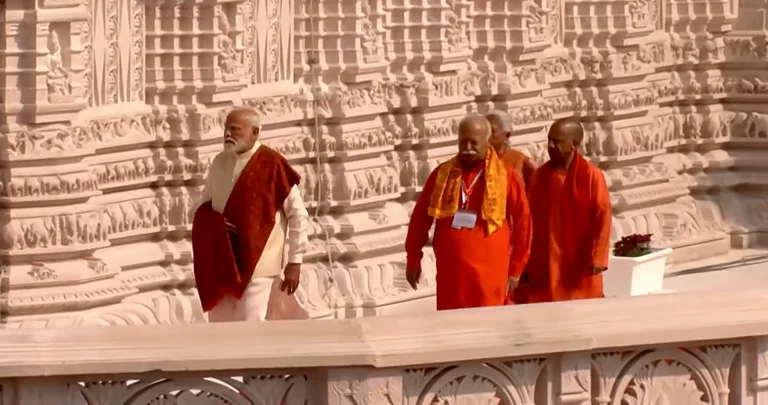Ram Navami commemorates the birth of Lord Rama, the embodiment of dharma (righteousness) and maryada (propriety), whose life and teachings continue to inspire generations. The new Ram Mandir stands as a unifying symbol for Hindus across the globe, transcending regional, linguistic, and cultural divides. It is a testament to the unwavering faith of millions who have awaited this momentous occasion—a moment that unites devotees in a shared celebration of devotion and love for Lord Rama.
Going to the Ram Mandir on Ram Navami is like going on a spiritual journey for devoted Hindus. When a devotee experiences the sacred deity's darshan (sight), their hearts are filled with reverence and delight as they get a concrete and meaningful opportunity to connect with Lord Rama's divine presence. With the opening of the new Ram Mandir on Ram Navami, a period of rebirth and reaffirmation of faith is marked. It serves as a reminder to followers to imitate Lord Rama's unshakable devotion to the truth, his infinite compassion, and his unwavering courage.
Temple inauguration and consecration ceremony
On January 22, 2024, the temple carried out its Pran Pratishtha ceremony, which drew over 7,000 visitors, including Bollywood celebrities, notable sports, business titans, and spiritual leaders. The ceremony was presided over by Prime Minister of India, Narendra Modi. The consecration ceremony was heavily publicized as it was screened in theaters like PVR INOX hosting live streams for viewers, TV channels broadcasting the ceremony live, and airlines offering special flights between Delhi and Ayodhya on the day of the inauguration.
Significance of the Ayodhya Ram Mandir for Hindus
For Hindus, one of the most significant places to go on pilgrimage is the Ayodhya Ram Mandir. It is revered as a sacred spot and is thought to be the birthplace of Lord Ram. After decades of struggle for the temple's construction, the Hindu community views the temple's erection as a symbolic success.
It is believed that the temple will play a role in Ayodhya's growth as a significant religious and cultural hub. Additionally, it is anticipated to boost the region's economy and produce jobs. Millions of devotees from all around India and the world are predicted to visit the temple, helping Ayodhya grow into a significant religious and cultural hub.
Inscriptions and Symbolism
The new Ram Mandir is a vision realized through the dedication and craftsmanship of countless artisans and devotees. Its architectural design is a harmonious blend of ancient Vedic principles and modern engineering, paying homage to the grandeur of India's temple-building traditions. Embedded within the very stones of the Ram Mandir are inscriptions that serve as a bridge between the past and the present, carrying forward the legacy of Lord Rama's divine saga. The temple walls are adorned with intricate sculptures depicting pivotal moments from the Ramayana, from Rama's exile to the epic battle with the demon king Ravana.
One notable feature is the depiction of the 'Shri Ram Janmabhoomi Tirtha Kshetra,' which signifies the sacred land where Lord Rama was believed to have been born. This inscription, etched in Sanskrit, serves as a reminder of the historical and religious significance of Ayodhya as the birthplace of Lord Rama.
The temple complex also features a series of carved panels known as the 'Ram Katha Kunj,' narrating the epic story of the Ramayana through exquisite sculptures. Each panel tells a chapter of the divine saga, inviting devotees to immerse themselves in the timeless tale of dharma, righteousness, and the victory of good over evil.
How to Reach the Ayodhya Ram Mandir
By Air - A number of airlines fly to Maharishi Valmiki International Airport in Ayodhya, which is around 10 km from Ayodhya Dham, from major cities. The airports in Varanasi, Gorakhpur, Prayagraj, and Lucknow are also accessible.
By Road - It's quite simple to get here from anywhere thanks to the 24-hour services of Uttar Pradesh Transport Corporation buses. Approximately 130 km separates the city from Lucknow, 200 km from Varanasi, 160 km from Prayagraj, 140 km from Gorakhpur, and approximately 636 km separates it from Delhi. Buses from Gorakhpur, Delhi, and Lucknow are often available. According to their schedule, buses are also accessible from Prayagraj, Varanasi, and other locations.
By Train - The district's two main train stations, Ayodhya Cantt and Ayodhya, are well-connected to practically all of the major towns and cities. Ayodhya can be reached by rail from Lucknow in 128 km, Gorakhpur in 171 km, Prayagraj in 157 km, and Varanasi in 196 km.
The best season to visit the Ayodhya Ram Mandir, also known as the Ram Janmabhoomi Temple, largely depends on personal preferences and weather conditions. However, considering the climate and festivities, the ideal time to visit Ayodhya and the Ram Mandir is during the winter months, from October to March.
During this period, the weather in Ayodhya is generally pleasant, with cooler temperatures and a comfortable atmosphere for exploring the temple complex and the city. The days are mild and sunny, making it enjoyable to stroll through the temple grounds, take part in prayers and rituals, and immerse oneself in the spiritual ambiance.
The temple darshan timings are from 7:00 AM to 11:30 AM and from 2:00 PM to 7:00 PM. For Aarti passes, visitors should arrive at the camp office at Shri Ram Janmabhoomi, 30 minutes before the aarti time with a valid government ID proof. To inquire about visiting the temple, visitors can check the official website of the Ram Janmabhoomi Trust: https://srjbtkshetra.org/. Here, you can find updated information on ticket availability, darshan timings, Aarti passes, and any other requirements for visiting the Ayodhya Ram Mandir.
Diwali and Ram Navami can be quite crowded due to the influx of pilgrims and tourists. Therefore, visitors should plan their trip accordingly, book accommodations in advance, and be prepared for larger crowds at the temple during these times.



























